Login form
Poison Ivy
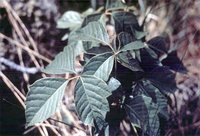
According to the American Academy of Dermatology, an estimated 10 to 50 million people in this country have an allergic reaction to poison ivy each year. Poison ivy is often very difficult to spot. It closely resembles several other common garden plants, and can also blend in with other plants and weeds. But if you come into contact with it, you'll soon know by the itchy, blistery rash that forms on your skin.
In this article, you'll discover how poison ivy causes that rash, learn where it grows, how to get rid of it and how to spot it before you get too close.
Poison Ivy Basics
Poison ivy is a red, itchy rash caused by the plant that bears its name. Many people get it when they are hiking or working in their garden and accidentally come into direct contact with the plant's leaves, roots, or stems. The poison ivy rash often looks like red lines, and sometimes it forms blisters.
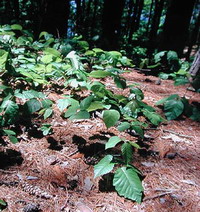 The culprit behind the rash is a chemical in the sap of poison ivy plants called urushiol (oo-roo-shee-ohl). Its name comes from the Japanese word "urushi," meaning lacquer. Urushiol is the same substance that triggers an allergic reaction when people touch poison oak and poison sumac plants. Poison ivy (Toxicodendron radican), Eastern poison oak (Toxicodendron quercifolium), Western poison oak (Toxicodendron diversilobum), and poison sumac (Toxicodendron vernix) are all members of the same family -- Anacardiaceae
The culprit behind the rash is a chemical in the sap of poison ivy plants called urushiol (oo-roo-shee-ohl). Its name comes from the Japanese word "urushi," meaning lacquer. Urushiol is the same substance that triggers an allergic reaction when people touch poison oak and poison sumac plants. Poison ivy (Toxicodendron radican), Eastern poison oak (Toxicodendron quercifolium), Western poison oak (Toxicodendron diversilobum), and poison sumac (Toxicodendron vernix) are all members of the same family -- Anacardiaceae
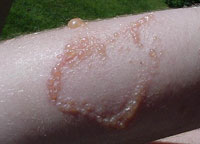
About 85 percent of people are allergic to the urushiol in poison ivy, according to the American Academy of Dermatology. Only a tiny amount of this chemical -- 1 billionth of a gram -- is enough to cause a rash in many people. Some people may boast that they've been exposed to poison ivy many times and have never gotten the rash, but that doesn't necessarily mean they're not allergic. Sometimes the allergy doesn't emerge until you've been exposed several times, and some people develop a rash after their very first exposure. It may take up to ten days for the rash to emerge the first time
Poison Plants
Because urushiol is found in all parts of the poison ivy plant -- the leaves, stems, and roots -- it's best to avoid the plant entirely to prevent a rash. The trouble is, poison ivy grows almost everywhere in the United States (with the exception of the Southwest, Alaska, and Hawaii), so geography won't help you. The general rule to identify poison ivy, "leaflets three, let it be," doesn't always apply. Poison ivy usually does grow in groups of three leaves, with a longer middle leaf -- but it can also grow with up to nine leaves in a group.
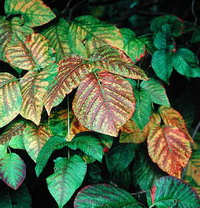
Here are some other ways to identify the poison ivy plant:
· It generally grows in a cluster of low, weed-like plants or a woody vine which can climb trees or fences.
· It is most often found in moist areas, such as riverbanks, woods, and pastures.
· The edges of the leaves are generally smooth or have tiny "teeth." Their color changes based on the season -- reddish in the spring; green in the summer; and yellow, orange, or red in the fall.
· Its berries are typically white.
Poison ivy's cousins, poison oak and poison sumac, each have their own unique appearance.
Poison oak grows as a shrub (one to six feet tall). It is typically found along the West Coast and in the South, in dry areas such fields, woodlands, and thickets. Like poison ivy, the leaves of poison oak are usually clustered in groups of three. They tend to be thick, green, and hairy on both sides.
Poison sumac mainly grows in moist, swampy areas in the Northeast, Midwest, and along the Mississippi River. It is a woody shrub made up of stems with rows of seven to thirteen smooth-edged leaflets.
Poison Ivy and the Immune System
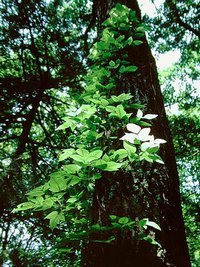
The body's immune system is normally in the business of protecting us from bacteria, viruses, and other foreign invaders that can make us sick. But when urushiol from the poison ivy plant touches the skin, it instigates an immune response, called dermatitis, to what would otherwise be a harmless substance. Hay fever is another example of this type of response; in the case of hay fever, the immune system overreacts to pollen, or another plant-produced substance.
Here's how the poison ivy response occurs. Urushiol makes its way down through the skin, where it is metabolized, or broken down. Immune cells called T lymphocytes (or T-cells) recognize the urushiol derivatives as a foreign substance, or antigen. They send out inflammatory signals called cytokines, which bring in white blood cells. Under orders from the cytokines, these white blood cells turn into macrophages. The macrophages eat foreign substances, but in doing so they also damage normal tissue, resulting in the skin inflammation that occurs with poison ivy.
The allergic reaction to poison ivy is known as delayed hypersensitivity. Unlike immediate hypersensitivity, which causes an allergic reaction within minutes of exposure to an antigen, delayed hypersensitivity reactions don't emerge for several hours or even days after the exposure.
Most people don't have a reaction the first time they touch poison ivy, but develop an allergic reaction after repeated exposure. Everyone has a different sensitivity, and therefore a slightly different reaction, to poison ivy. Sensitivity usually decreases with age and with repeat exposures to the plant.

